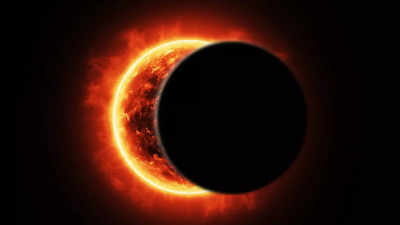Solar Eclipse 2024: Do's And Don'ts To Follow On The Day Of Surya Grahan
A solar eclipse, also known as Surya Grahan, occurs when the moon passes between the sun and the earth, blocking out the sun's light partially or entirely.
The solar eclipse has always been seen as an important celestial event and has fascinated humans for centuries. From the various myths that have covered the phenomena to the genuine advice given by agencies and elders, the Surya Grahan is for sure one of the most awe-inspiring phenomena that takes place.
What is a Solar eclipse?
What is a Solar eclipse?
A solar eclipse happens when the moon, in its orbit around the Earth, places itself directly between the Earth and the Sun. This placement or alignment of the moon causes it to cast a shadow on Earth, leading to a temporary darkening of the sky during the day. There are different types of solar eclipses, including total, partial, and annular, depending on the placement, the amount of space it covers, and the distance between the Earth, Moon, and Sun.
When does an eclipse take place?
A solar eclipse happens when the moon, in its orbit around the Earth, places itself directly between the Earth and the Sun. This placement or alignment of the moon causes it to cast a shadow on Earth, leading to a temporary darkening of the sky during the day. There are different types of solar eclipses, including total, partial, and annular, depending on the placement, the amount of space it covers, and the distance between the Earth, Moon, and Sun.
When does an eclipse take place?
And this year, the first Solar eclipse or Surya grahan of the year, is set to take place on April 8 where the moon will completely block the sun, thus resulting in a complete Solar eclipse.
Will it be visible in India?
A solar eclipse is of 4 types - total eclipse, annular eclipse, hybrid eclipse, and partial eclipse. And while they are all extremely exceptional in their ways, they are not always visible across the Earth. The visibility of the eclipse depends on one's geographic location. Sometimes, they may not be visible at all from certain regions. At times, they are visible across a whole continent, and at other times you can only see them in specific countries.
The first solar eclipse of this year, which is a total eclipse and is set to take place on April 8, will not be visible in India.
This eclipse will only be visible in North America, Mexico, the United States, and Canada.
The first solar eclipse of this year, which is a total eclipse and is set to take place on April 8, will not be visible in India.
This eclipse will only be visible in North America, Mexico, the United States, and Canada.
The many different beliefs around the eclipse
Throughout history, solar eclipses or Surya grahans, have been surrounded by many different beliefs and explanations. Many ancient civilizations believed that a solar eclipse was a sign of impending doom, the anger of gods, or the result of giant monsters trying to eat the sun so that life on Earth perishes. And so when the eclipse started people started to pray and ask for forgiveness. When the eclipse used to fade away, it was seen as a sign that God successfully answered their prayers.
Throughout history, solar eclipses or Surya grahans, have been surrounded by many different beliefs and explanations. Many ancient civilizations believed that a solar eclipse was a sign of impending doom, the anger of gods, or the result of giant monsters trying to eat the sun so that life on Earth perishes. And so when the eclipse started people started to pray and ask for forgiveness. When the eclipse used to fade away, it was seen as a sign that God successfully answered their prayers.
What does NASA say?
“The Monday, April 8, 2024, a total solar eclipse will cross North America, passing over Mexico, the United States, and Canada. The total solar eclipse will begin over the South Pacific Ocean. Weather permitting, the first location in continental North America that will experience totality is Mexico’s Pacific coast at around 11:07 a.m. PDT. The path of the eclipse continues from Mexico, entering the United States in Texas, and traveling through Oklahoma, Arkansas, Missouri, Illinois, Kentucky, Indiana, Ohio, Pennsylvania, New York, Vermont, New Hampshire, and Maine. Small parts of Tennessee and Michigan will also experience the total solar eclipse. The eclipse will enter Canada in Southern Ontario, and continue through Quebec, New Brunswick, Prince Edward Island, and Cape Breton. The eclipse will exit continental North America on the Atlantic coast of Newfoundland, Canada, at 5:16 p.m. NDT.”


Comments
Post a Comment